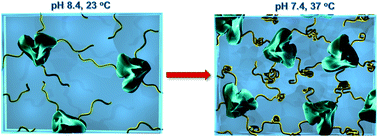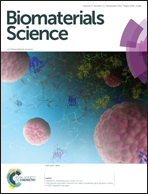Engineering highly swellable dual-responsive protein-based injectable hydrogels: the effects of molecular structure and composition in vivo
Abstract
Stimuli-responsive hydrogels, known as smart hydrogels, are three-dimensional amphiphilic or hydrophilic polymer networks that are able to change their volume or phase, and other properties, including viscosity, structure, and dimension, in response to changes in pH, temperature, and magnetic or electric field. Highly swellable, dual-responsive bovine serum albumin (BSA)-based injectable hydrogels are prepared here by the chemical conjugation of pH- and temperature-responsive oligo(sulfamethazine acrylate-co-N-isopropylacrylamide) (oligo(SMA-co-NIPAM)) copolymers on the surface of BSA through carbodiimide-mediated chemistry. The pH- and temperature-responsive oligomer-bearing BSA conjugates show rapid sol-to-gel phase transition properties. Specifically, the free-flowing conjugates at high pH (pH 8.4, 23 °C) are transformed to a viscoelastic gel under physiological conditions (pH 7.4, 37 °C). The swelling ratio, gel strength, and pore size of the BSA hydrogel were tuned by altering the conjugation ratio of the oligo(SMA-co-NIPAM) copolymers of various lengths and compositions to BSA. Subcutaneously administered BSA conjugate sols into the dorsal region of Sprague-Dawley rats formed an in situ gel. When the oligo(NIPAM) content in the hydrogel was high, the degradation rate of BSA hydrogels was remarkably slow, and two weeks after in vivo administration, the hydrogels with high oligo(NIPAM) had swollen more than 4-fold. An in vivo biodegradation study demonstrated that no necrosis or hemorrhage was observed in the tissues with the hydrogels. The concurrent stimuli-responsivity under physiological conditions and high elasticity suggest that these smart hydrogels may open a new avenue for hydrogel applications.



 Please wait while we load your content...
Please wait while we load your content...